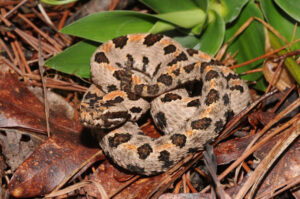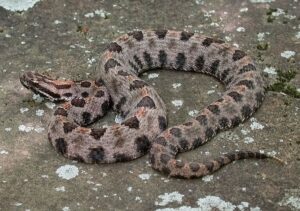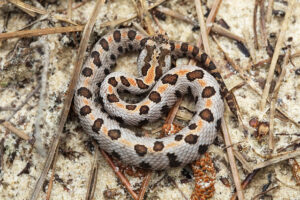Western Pygmy Rattlesnake (Sistrurus miliarius streckeri)
Updated on
25/04/2024The western pygmy rattlesnake is a small, colorful, nocturnal pit viper subspecies that calls southcentral United States its home. The subspecific name streckeri is in honor of American naturalist, John Kern Strecker. Other common names of the snake are Strecker’s pygmy rattlesnake, pygmy rattlesnake, ground rattlesnake, western ground rattlesnake, and southern pygmy rattlesnake.
Scientific Classifications
- Suborder:Serpentes
- Family:Viperidae
- Genus:Sistrurus
- Species:S. miliarius
- Subspecies:S. m. streckeri
Conservation Status
Description
Size
The total length of an adult, including the tail, is 16-25 in (40-63 cm). This makes it the smallest rattlesnake in North America.
Color and Appearance
The ground color of the western pygmy rattlesnake is light brownish gray. Most of them have a rust-colored stripe running down their backs. There is a distinct and very irregular color pattern, with the middorsal series of blotches being clearly wider than they are long. There are only 1-2 series of spots along the sides, with the upper ones being longer than they are wide. Any dark pigment on the dusky cream or gray belly is diffuse with the blotches, usually not wider than a single scale.
This species has the lowest number of ventral scales. It has a slender tail with a tiny rattle and keeled scales. The head has a prominent black stripe making an angle from the eye to the corner of the mouth. The pupils are vertical, and the anal scale is undivided.
Are They Dangerous to Humans
Humans rarely encounter the snake due to its extremely secretive nature. The defense mechanism of this rattlesnake varies with individuals. Some defend themselves vigorously by coiling, jerking their heads, sounding their rattles, and striking at any movement. The rattle sound is a faint buzz like a grasshopper and can be heard just about a yard away. Others stay motionless and try to escape only when touched. But all bite when threatened.
Although its bite is not fatal, it calls for immediate medical attention. The venom is fairly toxic, but as it is only delivered in small amounts, no human deaths have been reported due to its bite, till date.
Western Pygmy Rattlesnakes at a Glance
Distribution
In the US, it ranges from Mississippi (excepting the southeast of the Pearl River Valley), north into central and southeastern Oklahoma, southern Missouri, Arkansas, and southwestern Tennessee, and west through Louisiana into eastern Texas.
Habitat
The western pygmy rattlesnake prefers south-facing, partially wooded, rocky hillsides, in woods near rock ledges, near glades, and along the margins of meadows and forests.
Late spring and early summer are when it basks in rocky open places, near brushpiles, or along roadsides near glades and woodlands. It is active from mid-April to mid-October.
Lifespan
Though its lifespan in the wild is unknown, it lives up to 16 years in captivity.
Predators
The pit viper is preyed upon by kingsnakes, hawks, Virginia opossums, skunks, raccoons, and owls.
Diet
They eat a variety of small snakes, lizards, mice, and occasionally insects and small frogs. They forage with their heat-sensing facial pits and inject venom with their hollow fangs to catch prey.
Reproduction
Ovoviviparous (gives birth to live young from eggs that hatch inside the body)
Courtship and breeding take place in spring, with the young being born from late August through September. 3-7 young form a litter. The newborns are 4-7.5 in (10.16-19.05 cm) long, paler than the adults, and have yellow tail tips.
Source
projectnoah.org, i.pinimg.com, venombyte.com, flickr.com










